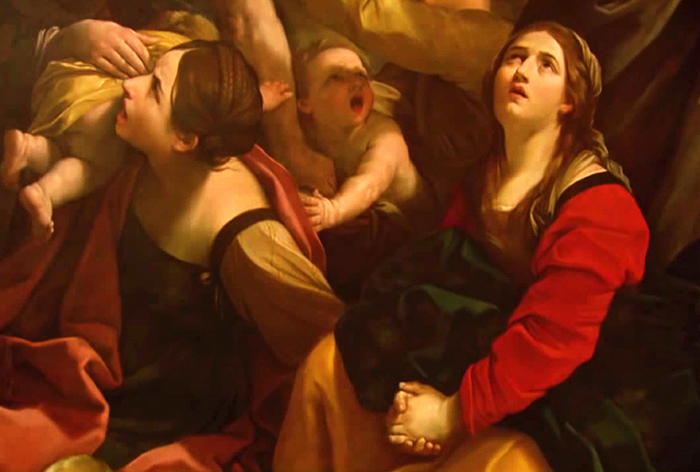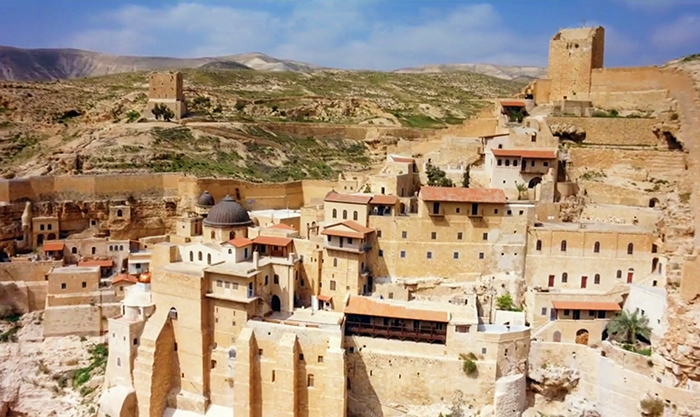
Meaning "house of bread" or "house of food," the name identifies two town reported in the Bible, the more famous of which is remebered as the city to which Ruth came as a total stranger out of loyality to Naomi, as well as the birthplace of David (1 Sam 17:12; he was also anointed king by Samuel here, 16:1) and Jesus (Matt 2:1; Lk 2:4). The less famous Bethlehem lay in the territory alloted to the tribe of Zebulun (Jos 19:15). An Arab village by the name of Bayt Lahm about 11km (7 miles) north-west of Nazareth suggests its ancient location. Apart from its sole reference in Joshua, we know nothing about it, though it has been suggested by some scholars as the home-town of the judge Ibzan (Judg 12:10).

The more famous of the two towns lies about 9km (6 miles) south of Jerusalem on the secondary land route running along the mountain ridge from Beersheba through Hebron and on to the capital. The town is first mentioned in the OT in Gen 35:19, though the text suggests that it had earlier on gone by the name of Ephrath; as time went on the two names became synonyms (see Ruth 4:11; Mic 5:2).
Open Map ☰
In Biblical Times
The origin of the city is unknown. Archaeological excavations indicate that the original town was located further down the slopes than the present city which sits atop two ridges separated by a saddle. The territory was allocated to Judah, but it had already gained some fame before that as a result of Rachel, Jacob's beloved wife, who died and was buried round about there (Gen 35:19). The tomb is still there (located by the side of the main road from Jerusalem); though it used to be venerated by all who lived around there, it has been taken over in recent years almost exclusively by Israelis.
Though mentioned about four dozen times in the Bible (8x in the Gospels), the city did not seem to have been an important place; nothing significant apart from what has so far been mentioned above seemed to have occupied Bethlehem's history in biblical times. The city may have survived in trades in the natural chemicals that the Dead Sea—easily assessible through the Kidron Valley which passed near by—produced and possibly spices from caravaneers from the east. Even when David became king upon the death of Saul and before the northern tribes came over to his side, he reigned in Hebron instead (2 Sam 2:1). Bethlehem, however, suffered one of the most dastardly murders in the history of the world: Herod's command for the male children "two years old and older" to be killed (Matt 2:16). Anyone who doubted if Herod did such a thing didn't know Herod at all. The incident is now famously known as "the Massacre of the Innocent."

In Post-Biblical Times
Bethlehem gained vital strategic importance once the Romans (read Herod) built the aqueduct that brought water from the springs near Hebron to Jerusalem. The aqueduct passed through Bethlehem. Capturing Bethlehem would hold the capital hostage. Bethlehem became an important pilgrimage center once Constantine nationalized the Christian faith and Queen Helena, his mother, built a basilica (the Church of Nativity) to mark the place where Jesus was supposed born, and the trade in religious tourism, souvenirs, and superstiions was born (and continues today). Jerome, and his parties of supporters, stayed there, where he finished, among other writings, his translation of the Bible into Latin. The surrounding desert also attracted hermits and monks, leading to the establishment of the famous Mar Saba Monasteries above the Kidron Valley. Bethlehem grew, as a result, into a largely Christian city. This did not change even when the Muslims conquered the country in the 7th Cent. Bethlehem was among one of the first cities to fall to them; its hold on the water supply to Jerusalem made that a necessity. Bethlehem, however, did not go under and, instead became a center of Ghassanid (Syrian-Arab Christians) growth and development, best represented, perhaps by John of Damascus, "the last of the Eastern Fathers" (but resided in Bethlehem, and is known mostly through his writings which were in Greek).

The city, inspite of its allure as the birthplace of the Saviour, has always played second fiddle to Jerusalem. In the early 1850s, however, international relationships spilled over into the life of Bethlehem. The background that played into the politicians' hands was the fact that the relationships between the many different denominations have always been uneasy esp.,given the jealousy with which they occupied the very limited space in the various historic churches in the country. This was particular bad in the Holy Sepulchre. The Russian tzar, Nicholas I, had been inching to expand at that time, and had set his eyes on the Ottoman lands to the south of his country. Knowing that the French—despite their obviously atheistic philosophies—would support the Roman Catholics come what may, he claimed it a national right of Russia to protect the rights of the Orthodox Christiand everywhere. One night it was discovered that the golden star that had adorned the altar in the Church of Nativity had been pried up and stolen (later investigations suggested the culprits were Orthodox monks), the tsar claimed as a pretext that his "international" subjects were in danger, and he invaded Ottoman-dominated Wallachia and Moldovia (Palestine was then part of the Ottoman Empire). The French and British saw it for what it was—a bad excuse for a land-grab—and attacked Russia. Thus was the Crimean War (1853-1856) war birthed.
Though Bethlehem resides in the West Bank, officially Palestinian territory, it has been besieged in the last three decades by Israeli settlers of one of the most radical blocks, the Gush Etzion, with the open approval of their politicians. Israeli settlements and settler ring-roads and tunnels (on which no Palestinian can drive without first obtaining permission) now surround the city on all sides. Life in Bethlehem today is tought but they are not giving in to despair (which comes easily). By hardwork and determination, the Bethlehem University, e.g., is the best in the country, and Bethlehamites are among the most entrepreneurial and ready to do things for themselves rather than wait for things to change. The temptation to just give up and to emigrate, however, remains a constant danger to its survival. In this the amazing people at the Bethlehem Bible College, have played their (in their own opinion, no doubt, small) important part.
(Bethlehem has a very special place in my heart. It was here, at the check-point, that I first witnessed for myself the atrocious treatment of the Palestinians by Israeli soldiers. My thought then—as now, after five visits—was to ask how could a people who have had to suffer the horror and pure injustice of the Kristallnacht and the Holocaust stand to treat anyone else like that. My encounters, on two separate occasions, with Israeli settlers in an underground cistern at Herodion only etched that question deeper.)

Further Reading & Resources:
Nicholas Blincoe, Bethlehem. Biography of a Town. London: Constable, 2017. This would have been a very useful introduction if Blincoe had been a more careful researcher or possessed a more adequate understanding of the Bible. That the "Gospel of Matthew was written at least a hundred years after the events it purports to describe" (p70; he later claims the same thing for Luke) is simply poor scholarship by any standard.

©ALBERITH
190521lch